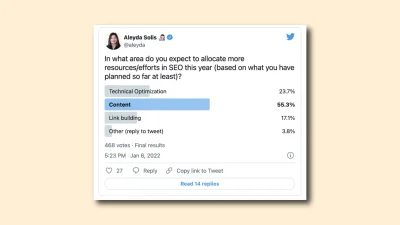Optimizing blog pages for SEO

In the digital landscape, SEO is crucial to a blog’s success. A well-optimized blog not only attracts more traffic, but also creates more relevant traffic. Let’s look at the most important SEO elements for blogs and why they are important.
A second goal of a blog for me is to get the response “I saw you had written about topic x or y, interesting how you describe it, could you pick this up for us too?”. That is indicative of a quality written article that also ranks high in Google.
Understanding why SEO is important for your blog
SEO is not just a buzzword; it is the backbone of your online visibility. As a marketing manager, you know that visibility equals reach and potential conversions. So, why then is SEO crucial for your blog?

How search engines rate content
Search engines like Google are constantly looking for valuable and relevant content to present to their users. They use complex algorithms that evaluate factors such as content quality, relevance, backlinks and user experience. If you understand how these mechanisms work, you can tailor your content accordingly. For this, see also this article.
A blog is often written for SEO
Many blogs are written primarily with SEO in mind. That’s because an optimized blog post can help you rank higher in search engines, leading to more organic traffic to your website. But SEO goes beyond simply increasing traffic; it’s about attracting the right kind of traffic.
During a blogging strategy, the goal is often to become a thought leader within a market. Not only does this provide direct conversions on the website, it also ensures recognition among searchers. Consider even higher customer retention.
Finding the balance between the visitor and Google
It’s a delicate balance between writing for your audience and for the search engines. You want to create content that finds resonance with your audience, but is also picked up by search engines. Finding this balance means staying authentic and relevant while still applying SEO principles that help your content stand out.
It is becoming easier and easier to find this balance by writing right more for the visitor. Consider even writing articles where there is no volume. Google is getting smarter, so quality articles will increasingly win out over “SEO articles.”
Read more about how I use specific pages for SEO
Each page has its own purpose within SEO. Through the links below, read more about how I deploy specific pages within an SEO journey.
- Leveraging product pages for SEO
- How to leverage my homepage for SEO
- Category pages optimized for SEO
- The effect of an about us page on SEO
Choosing the right keyword
Keywords are at the heart of SEO. They are the terms and phrases people type into search engines. Choosing the right keywords for your blog can mean the difference between being seen by your target audience or being lost in the sea of online content.
The importance of a content strategy
Before delving into keywords, it is essential to have a solid content strategy. This will help you determine your goals, your target audience and how to deliver value through your blog. A content strategy takes care of a number of things:
- The topics you write for are interesting either for SEO or for your CPI.
- Content is written structurally, so you move forward weekly (consistency is key).
- While implementing the strategy, you don’t spend hours drafting it, but can really focus on the content itself.
How do you create a content strategy?
A content strategy is not just a list of blog topics. It involves identifying the needs and interests of your target audience, analyzing the competition and determining your unique value proposition. By combining this with your business goals, you can create a plan that will help you consistently deliver valuable content.
How to balance search intent and search volume
Not all keywords are created equal. Some have high search volume but low conversion rates, while others are more specific and have a clear search intent. It is essential to strike a balance between the two to maximize both traffic and conversions.
You can simplify the choice by thinking about what your OKRs are and from these OKRs set your marketing goals. From these goals, you can choose between increased traffic / brand awareness or increased website conversions.
Also write for the search terms without volume sometimes
Although it may not seem intuitive, search terms with low or even no search volume can sometimes be gold mines. These are often very specific terms that indicate a clear intention. By writing for these terms, you can target a niche audience that is ready to take action.
A website that writes only for the search terms on which there is volume is also likely to get a negative mark from Google at some point. Pay close attention to this when determining your content strategy.
My checklist for a blog page in a table
A brief overview of the main components of a blog page, when you set it up partly for SEO. My advice is to make this a standard template (feel free to use my blog page as an example).
| SEO element | Priority |
|---|---|
| Unique, valuable content(1) | High |
| Responsive design (mobile optimization) | High |
| Page title and meta description | High |
| Internal and external link structure | High |
| Image optimization (alt-texts, compression) | High |
| Page speed(2) | High |
| URL structure and optimization | High |
| H1-H6 header structure | Middle |
| Social share buttons | Middle |
| Multimedia content (video, infographics) | Middle |
| Keyword optimization | Middle |
| Breadcrumbs | Middle |
| Schema markup (e.g., for reviews) | Low |
| Comment section (for engagement) | Low |
| Presence of a search function | Low |
While all of the above are relevant, their priority may vary depending on specific projects, audiences or business needs. It is also important to remember that SEO is a dynamic field, so what is considered a high priority today may change tomorrow. Staying up-to-date with the latest industry best practices and guidelines is essential.
Optimizing your title and meta description
In today’s competitive digital world, first impressions are everything. Your page title and meta description are often the first things a potential visitor sees in search results. Therefore, optimizing these elements is crucial to standing out and getting that coveted click.

Why titles are crucial for click-through rates
A catchy title is like a digital handshake. It gives an immediate impression of what a visitor can expect when they click on your link. A relevant and engaging title attracts attention and entices users to discover more, which increases the click-through rate (CTR). A higher CTR, in turn, can lead to better search engine rankings.
In doing so, make sure the entire snippet in Google matches the content of your article. This prevents pogosticking (that a visitor clicks on your result, then goes back to the search results page and does find what he or she is looking for at a competitor).
How to write a catchy meta description
The meta description is your chance to tell in a few short sentences what your content has to offer(3). Think of it as the back cover of a book. It should be intriguing enough to convince someone to read on, without giving everything away. Integrating your focus keyword and providing a clear value proposition can help increase your CTR.
How to write a catchy page title
An effective page title is both informative and engaging. It should capture the essence of your content in a few words while piquing the reader’s curiosity. By focusing on relevance, clarity and a touch of creativity, you can create a title that will be appreciated by both search engines and people.
Creating unique, valuable content
In today’s crowded digital space, unique and valuable content is the key to standing out and building a loyal audience. This is perhaps the most important point of all those described here (and at the same time the most labor-intensive).
My idea of good content is that a customer asks me something and I can simply send the link of the article where the answer is. Is your content not good enough for this? Then there is room for growth in it.
The importance of depth and relevance
Surface-level content is everywhere. But in-depth, well-researched articles that offer real insights and solutions are rare and sought after. By delving into topics and offering relevant information, you position yourself as an expert and a reliable source of information.
How to stay authentic to your brand and audience
Authenticity is the key to building trust and loyalty with your audience. It is not just about honesty, but also about being consistent in your message and tone. By incorporating your brand voice into all your content, you create a recognizable and trustworthy experience for your readers.
Avoiding duplicate content
Duplicate content can hurt your SEO efforts and lead to confusion among your audience. Whether it is accidentally copied pages or reusing content on different parts of your website, it is essential to identify and address duplicates. This keeps your content fresh, relevant and valuable to your visitors and to search engines.
On some pages, I even go so far as to place unique call to actions so that I have (in %) less duplicate content on these pages. This is not the difference between a page 2 and position 1, but in competitive markets, every little bit helps.
Optimizing images and multimedia
In our visually driven online world, images and multimedia play a crucial role in engaging and holding visitors’ attention. But without proper optimization, they can also slow down your page load times and hinder your SEO performance.
The importance of alt text and image compression
Images are interesting to use, but search engines cannot “see” them the way we do. Alt text helps with this by providing a brief description of what is in the image, which improves both accessibility and SEO(4). In addition, compressing your images can reduce file size without losing quality, leading to faster load times. For more tips on this, check out my marketing and development checklist.
How multimedia improves the user experience
Videos, podcasts and interactive elements can take your content to the next level. They provide a dynamic way for visitors to interact with your content and can convey complex ideas quickly and effectively.
Balancing between appearance and speed
It’s tempting to stuff your site with high-res graphics and interactive multimedia, but you should always keep the user experience in mind. A slow site can put visitors off, so it is essential to strike a balance between visual flair and site performance.
Responsive design and mobile optimization
With an ever-increasing number of users accessing content through mobile devices, optimizing for them is no longer an option; it is a necessity. Before you go overboard in this. In your Google Analytics, see if a large portion of your visitors come via mobile. Is this the case? Then you can invest more in the mobile version of the website(5).
Why mobile first is essential in blogging
The “mobile first” principle is about designing and optimizing your website with mobile users as the primary target audience. This means considering the mobile experience first and then making adjustments for desktop users. Given the prevalence of mobile browsing, ignoring these users can drastically reduce your traffic and engagement.
How to reduce load times for mobile devices
Mobile devices often have less computing power and can operate on slower networks. Therefore, it is crucial to do everything you can to minimize load times. This could mean further compressing images, eliminating redundant scripts or using content delivery networks (CDNs).
Tips for a smooth mobile user experience
From easy-to-tap buttons to clear, readable text, there are many elements that combine to create a smooth mobile experience. It’s not just about speed; it’s about enabling your visitors to navigate through your content without frustration, no matter what device they’re using.
In this digital age, social media has become an integral part of our daily routines. It is not only a place where people keep in touch with friends, but also where they discover new content. For marketers and content creators, therefore, social media offer an unparalleled opportunity to expand their reach.

So-called “social signals,” such as likes, shares and comments, can be an indication of the popularity and relevance of your content. While the direct impact of social signals on search engine rankings is still subject to debate, they can help increase your online visibility. When people share your content, it increases your reach, which in turn can lead to more organic traffic to your site.
Content that resonates emotionally is often content that gets shared. Whether you offer deep insight, share a funny anecdote or simply deliver value in a way that is easy to understand, it’s all about connection. Add clear and accessible social share buttons, and you have a recipe for increased shareability.
Ways to promote interaction and engagement
Engagement is a two-way street. Ask questions, encourage responses, and respond to feedback and comments yourself. Hold polls, organize contests or invite your audience to share their own stories. By building a community around your content, you not only foster short-term engagement, but also build long-term loyalty.
Conclusion
SEO for blogs goes beyond keywords. By considering all aspects of SEO, from content to technical optimization, you can ensure that your blog performs better in search engines and becomes more valuable to your readers. It is an ongoing process, so staying abreast of best practices is essential.
- https://developers.google.com/search/docs/fundamentals/creating-helpful-content
- https://developers.google.com/search/docs/appearance/page-experience
- https://developers.google.com/search/docs/appearance/snippet
- https://developers.google.com/search/docs/appearance/google-images
- https://developers.google.com/search/docs/crawling-indexing/mobile/mobile-sites-mobile-first-indexing






